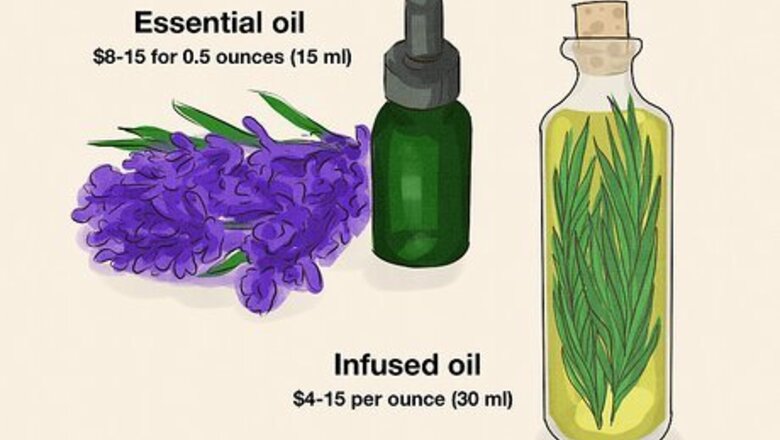
views
Noticing Differences Between Essential Oils and Infused Oils
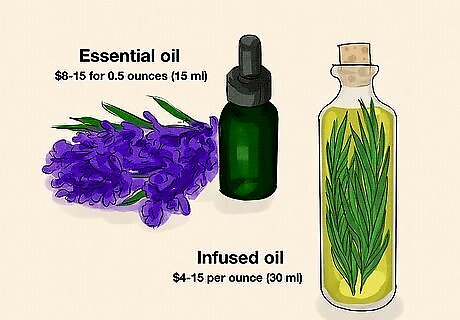
Notice differences in cost. Infused oils tend to be a lot cheaper than essential oils because they don't require the same extraction processes. (They don't require a hard-to-extract oil to make up the bulk of the product.) If the oil you are buying seems very cheap, it is probably infused rather than essential oil. Essential oils will typically cost $8-15 for 0.5 ounces (15 ml). Infused oils will typically cost $4-15 per ounce (30 ml).

Observe differences in concentration. Essential oils are highly concentrated, while infused oils are much more mild. Essential oils are so powerful that they should almost never be applied directly to the skin, but rather diluted in a carrier oil. Infused oils, on the other hand, are gentle enough to be used on bare skin.
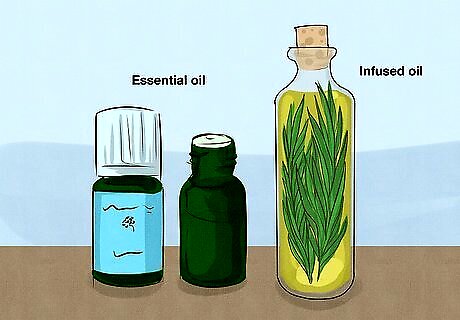
Recognize differences in packaging. Essential oils must always be packaged in dark glass bottles, as they can be easily damaged by bright sunlight. Infused oils are not damaged in the same way, and as such, may be packaged in either dark or light containers. Essential oils are generally packaged in 0.5 ounce (15 ml) dark glass bottles. (An extremely popular oil, such as lavender oil will sometimes be available in 1 ounce bottles). Infused oils are generally packaged in 1 ounce (30 ml) bottle or larger. These bottles may be either dark or clear glass.

Recognize popular essential oils and infused oils. If you are familiar with popular types of both essential and infused oils, you will be able to identify each more easily. Be aware that some plants can be used to create either type of oil. Popular essential oils include: lavender, oregano, patchouli, peppermint, and lemon. Popular infused oils include: calendula, st. johns wort, mullein, and comfrey.
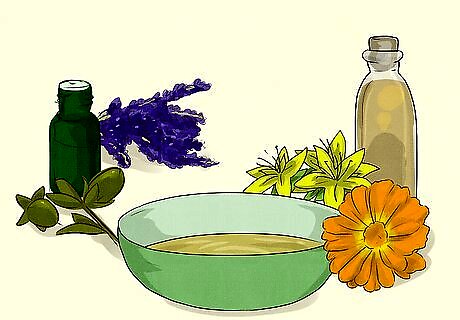
Use essential oils and infused oils in combination. You may choose to use essential oils and infused oils in combination. If you want to create a massage oil for example, you may begin with lavender infused in jojoba oil (for stress relief). Later you may choose to add a few drops of tea tree oil (for antiseptic purposes), citrus (for boosting mood), or oregano (for immune function). In this way, the already infused oil serves as your carrier oil, carrying with it many additional health benefits.
Recognizing Essential Oils

Learn about essential oils. Essential oils are aromatic compounds housed within plants. Essential oils may be located in bark, seeds, flowers, stems, roots, and other parts of plants. These oils are extracted using a variety of methods and can be used for medicinal, beauty, or culinary purposes. Common essential oils include tea tree oil, lavender, peppermint, patchouli, and lemon.
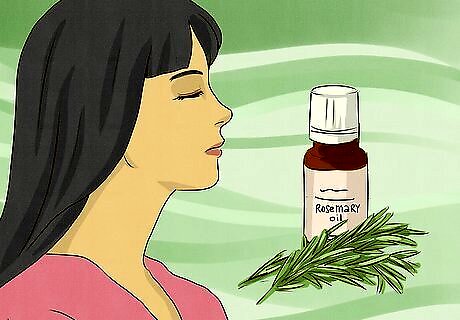
Study the properties of various essential oils. Essential oils are very useful for a wide variety of health, beauty, and mood-boosting applications. In order to understand essential oils, it is important to get a sense of some uses of different essential oils. Essential lavender oil has excellent calming properties. Essential geranium oil is a good oil for balancing emotions. Essential rosemary oil is great for inhaling when you have a cough or cold. Essential lemon or grapefruit oils are ideal as air fresheners, leaving a fresh aroma in a room.

Diffuse essential oils. The most popular way to utilize essential oils is called “diffusing.” This is when you use an appliance called an “essential oil diffuser” to release the essence of various essential oils into the air. Similar to a humidifier, the diffuser heats up the oil and turns it into vapor. This creates a wonderful scent and depending on your choice of oil, can have additional health benefits. Diffusers run from $20-100 and can be purchased online or at most health food stores. You can also heat water on your stove with a few drops of essential oil to achieve a similar effect.

Use essential oils topically. Another prominent use of essential oils involves topical application. This is when you apply 1-2 drops of oil to an area of your body for medicinal purposes, or as perfume. As essential oils are highly concentrated and very strong, it is recommended that you use a “carrier oil,” like coconut oil or avocado oil. Mix one drop of essential oil with three drops of carrier oil and apply to your skin. Try applying essential oils to your neck, the bottoms of your feet, or the backs of your wrists. Patchouli, lavender, and cedarwood oils are commonly used topically as a perfume.

Consume essential oils. Essential oils can have medicinal benefits when taken orally. You can use very small amounts of essential oils to replace herbs and spices in cooking, take essential oils as supplements in a veggie capsule (or added to applesauce), or add small drops to smoothies, tea, or other drinks. Peppermint oil can be used to give smoothies or baked good a minty taste, while also being extremely soothing to your tummy. Oregano oil can be used in place of dried oregano, while simultaneously boosting your immune function.
Understanding Infused Oils

Learn about infused oils. An infused oil (also known as a macerated oil) is a basic vegetable oil (such as, sweet almond oil, olive oil, grape seed oil) that has been infused with the flavor of a different plant. This is usually done by steeping leaves, flowers, stems, roots, or other parts of a plant, either with heat or for a long period of time. Common infused oils include arnica, comfrey, mullein, and St. Johns Wort.
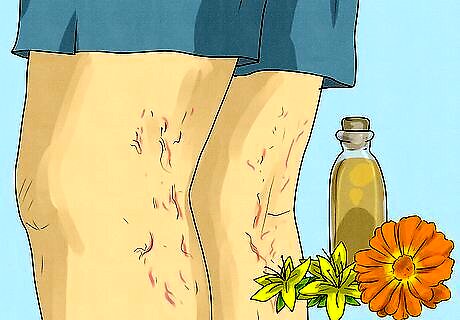
Study the properties of different infused oils. The most popular types of infused oils include Calendula oil (made from marigold flowers) and St. Johns Wort. Calendula is known for its soothing properties and is used in a variety of beauty products. St. Johns Wort infused oil can be used to treat an array of ailments, including sunburn, nerve pain, varicose veins, and hemorrhoids. Oil infusions are often made from a mix of herbs and flowers.
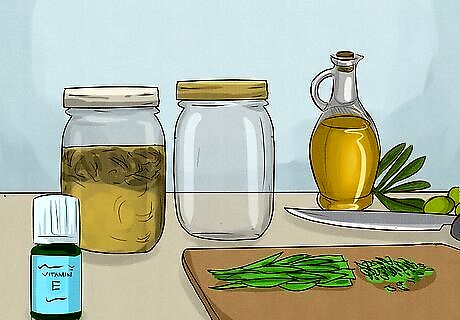
Make your own infused oils. One benefit of infused oils is that, unlike essential oils, they can be created at home. Doing so is easy. All you need is a “carrier oil” (olive oil, coconut oil, or jojoba oil are all good choices), dried herbs, spices, or flowers, and a clean, transparent, airtight container (ideally glass). Simply chop your plant matter as finely as possible. Then place your carrier oil and plant mater in your airtight jar, and place the jar in a sunny location for 2-3 weeks. Adding a few drops of either Vitamin E oil or Wheat Germ oil to your infusion can help prevent any bacteria from growing in your oil. You can speed up the process by infusing your oil in a slow cooker on low heat overnight.

Understand hydrosols. Hydrosols are not technically “oil infusions,” but hydrosols, essential oils, and infused oils are often grouped together, and all can be used for aromatherapy. Hydrosols are substances like rose water or lavender water. They are created as a byproduct of distillation. These fragrances can be used as perfumes, as air fresheners, in cooking (as with orange essence), or in cosmetics.
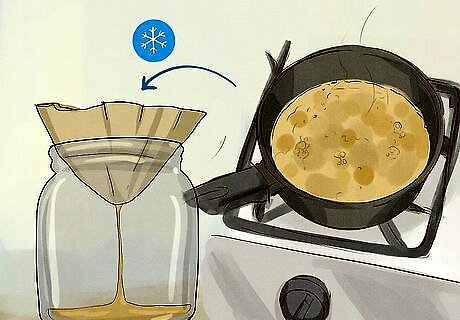
Create infused oils for cooking. One popular way to use infused oils is for cooking. These oils can be purchased at specialty grocery stores or created at home. Using olive, grapeseed, or avocado oil as your base, you can add a variety of herbs, spices, citrus, and/or nuts to create any flavor you desire. Infused cooking oils also make excellent gifts. Select your flavoring (whole or ground spices are fine). You will need approximately 2 Tbs. of flavorings for every 1 cup of oil. Heat your oil and flavorings in a saucepan over medium heat for about 5 minutes (until the liquid is bubbling). Remove from heat and allow to cool. Strain your oil using cheesecloth or a fine sieve. Bottle your oil in a glass, airtight container. Store your infused oil in the refrigerator for up to one month.



















Comments
0 comment